Sustainable Urban Freight for Energy-Efficient Smart Cities—Systematic Literature Review
Abstract
1. Introduction
1.1. Motivation—Importance of Sustainable Urban Freight in Smart Cities
- Energy-efficient and easily accessible urban mobility.
- Infrastructure for environmental protection and the reduction of carbon dioxide (CO2) emissions (e.g., smart building and smart living).
- Innovative technologies for sustainable-energy consumption.
- Interconnectivity (e.g., easy and affordable access to the broadband Internet).
- Intelligent urban services (for example, based on real-time sensor data).
1.2. Aim and Originality of This Paper
- Q1: What innovations are companies (logistics service providers) applying in last-mile delivery (LMD) for sustainable urban freight (SUF) in energy-efficient smart cities?
- Q2: What smart technologies enable the use of LMD for SUF applications in energy-efficient smart cities?
2. Materials and Methods
2.1. List of Abbreviations
2.2. Research Methodology
- Research questions addressed by the study,
- The sample, which is the focus of the review,
- The search strategy for the identification of relevant studies.
2.2.1. Extracting Papers
2.2.2. Inclusion and Exclusion Criteria
- Paper considers only policy making for SUF;
- Paper considers only endogenous factors for SUF (urban planning, urban development, etc.);
- Paper considers urban-mobility solutions only for passengers (not for goods).
- Paper considers the movement of goods (urban integration of transport and/or last-mile delivery) in smart cities.
- Paper investigates a company (logistics service provider), or group of companies (supply chain);
- Paper gives an answer to at least one of the research questions.
3. Descriptive Analysis
3.1. Distribution of Papers by Year and by Country
3.2. Distribution of Paper Sources and Subject Areas
3.3. Distribution of Research Methods
3.4. Distribution of Keywords
- In the six identified clusters, there are some duplications of similar keywords, because of the lack of well-established terminology in this area, which is typical for the early stage of research in a domain.
- Many keywords refer to activities at macro-level, such as urban planning, urban development, environmental sustainability, transportation system, city logistics, smart city/smart cities, sustainable logistics, and smart logistics.
- There is a very limited number of keywords (e.g., drones, electric vehicles, IoT, digital twins) that represent SUF innovations for smart cities at the micro level (suitable for implementation by logistics service providers).
- Keywords that pertain to the analysis of SUF for operationalization of energy-efficient smart cities at the micro-level (related to the management of last-mile delivery) are very limited.
4. Thematic Results
- Urban freight consolidation and trans-shipment for last-mile delivery;
- Choice of mode of transportation for last-mile delivery;
- Consumer as a Service Provider (CaaSP) in last-mile deliveries.
4.1. Logistics Innovations in SUF in Energy-Efficient Smart Cities
- Low—It is energy-efficient, even without the support of smart technologies.
- Medium—it is energy-efficient with some support from smart technologies.
- High—it is energy efficient only with the support of smart technologies.
4.1.1. LMD Consolidation and/or Trans-Shipment for SUF
4.1.2. Consumer as a Service Provider (CaaSP) in LMD for SUF
4.1.3. Mode of Transportation for LMD in SUF
4.2. Smart Technologies Which Enable the Application of ILMDs for SUF in Energy-Efficient Smart Cities
5. Discussion
5.1. Potential for Improving Energy Efficiency by SUF in Smart Cities
5.2. Assessment of the Innovations in LMD for SUF for Energy-Efficient Smart Cities
- High—reduced energy demand compared to the traditional urban freight (e.g., electric vehicles, cargo bikes). Medium—reduced energy demand in comparison to the traditional urban freight appears under certain favorable conditions (e.g., good weather).
- Low—reduced energy demand compared to traditional urban freight could appear only with the enabling of smart technologies (e.g., conventional van routing supported by IoT devices).
5.3. Recommendation for Future Research Directions
- LMD consolidation and/or trans-shipment in SUF: Models and methods for the planning and optimization of operations in mobile depots and mini-depots, with a focus on energy efficiency and infrastructure sharing. The economic viability is crucial for scaling up LMD consolidations and trans-shipment, and costing models for infrastructure sharing (among LSPs) in SUF are needed.
- Consumer as a service provider (CaaSP) in SUF: solutions for increasing the usage of crowd-shipping data in planning and optimizing the vehicle routing for LPSs to reduce the energy-demand and number of trips.
- Mode of transportation for LMD in SUF: Energy-efficiency models for drones are often highly theoretical, and related results are often contradictory, so multiple real-life case studies are needed. The operational simplicity and robustness of mobile robots in SUF will be tested for different scenarios and use cases. Autonomous vehicles for SUF require further research into the challenges of sensor, artificial intelligence, and blockchain technologies in routing, tracking, and authenticating the sustainability and safety of transportation while preserving data privacy. Upscaling of the use of electric vehicles will be investigated, with a focus on the application of the self-production and self-consumption of energy in smart cities (V2G vehicle to grid and V2V vehicle to vehicle). New models are needed for optimizing the operation of electric vehicles with limited battery capacity, while meeting the number of transport requests and minimizing fleet emptying.
- Smart technologies for SUF: Smart technologies support energy efficiency in smart cities by the reduction in energy (fuel) in the sustainable urban freight, due to better planning of deliveries and infrastructure sharing (e.g., they benefit from the reduced number of trips, due to a better load factor of vehicles). Improvement in energy efficiency is, however, not in the core interest of the studies in the analysis dataset. Future research that contributes to filling this research gap would be beneficial. Large data sets especially, enable resource pooling and capacity sharing among different stakeholders (LSPs). The challenge is the acceptance of the big data solution by LSPs, which are concerned about the breach of sensitive data. The challenges of data sharing, ownership, data cleansing and compliance with standards are critical in advancing big data applications in sustainable urban freight for smart cities. The digital twin is an interesting option in the framework of smart logistics (or Logistics 4.0), but its applications to the SUF in smart cities are very limited. This research topic will attract more interest from the academic community.
6. Conclusions
- There is a lack of well-established terminology in sustainable urban freight for energy-efficient cities, which is typical of the early stages of research in a domain.
- Topics important for an actionable approach to energy-efficient last-mile deliveries, namely trans-shipments/consolidation of parcels, are not reflected in keywords clusters, and would merit more attention in future research
- The topics of smart grids and renewable energy have not been sufficiently investigated in the case of sustainable urban freight. Thus, there is a gap with regard to research on flexible energy demand and storage management for the purpose of LMD in smart cities.
- Classifying the innovative solutions for sustainable urban freight in smart cities into three categories: (1) urban freight consolidation and/or trans-shipment in LMD; (2) the consumer as a service provider (CaaSP); and (3) LMD transportation mode.
- Identifying the smart technologies which enable sustainable and energy-efficient urban freight in smart cities. They are the Internet of things; big data, artificial intelligence, blockchain, and digital twin. Smart technologies support the energy efficiency related to the LMD in smart cities by a reduction in the energy demand (fuel) in sustainable urban freight, due to better planning of LMD and the sharing of infrastructure (e.g., the benefits from the reduced number of trips, due to a better load factor of vehicles).
- Exploring possible future research directions for SUF in energy-efficient smart cities.
- The proposal of a new tool, the so-called IEE matrix, which allows for an actionable classification of solutions in the area of sustainable urban freight, with respect to their level of interconnectivity and energy efficiency.
Author Contributions
Funding
Data Availability Statement
Conflicts of Interest
References
- Demographia World Urban Areas 18th Annual Edition. Available online: http://www.demographia.com/db-worldua.pdf (accessed on 20 December 2022).
- URBANET How Many People Live in Cities Worldwide? I Infographic. Available online: https://www.urbanet.info/world-urban-population/ (accessed on 2 January 2023).
- Hammer, S.; Kamal-Chaoui, L.; Robert, A.; Plouin, M. Cities and Green Growth: A Conceptual Framework; OECD Regional Development Working Papers; OECD Publishing: Paris, France, 2011; Volume 2011/08. [Google Scholar]
- Albino, V.; Berardi, U.; Dangelico, R.M. Smart Cities: Definitions, Dimensions, Performance, and Initiatives. J. Urban Technol. 2015, 22, 3–21. [Google Scholar] [CrossRef]
- Lewandowska, A.; Chodkowska-Miszczuk, J.; Rogatka, K.; Starczewski, T. Smart Energy in a Smart City: Utopia or Reality? Evidence from Poland. Energies 2020, 13, 5795. [Google Scholar] [CrossRef]
- Brzeziński, Ł.; Wyrwicka, M.K. Fundamental Directions of the Development of the Smart Cities Concept and Solutions in Poland. Energies 2022, 15, 8213. [Google Scholar] [CrossRef]
- Russo, F.; Rindone, C.; Panuccio, P. The Process of Smart City Definition at an EU Level. In Proceedings of the Sustainable City 2022, Rome, Italy, 10–12 October 2022; pp. 979–989. [Google Scholar]
- Ferraris, A.; Santoro, G.; Papa, A. The Cities of the Future: Hybrid Alliances for Open Innovation Projects. Futures 2018, 103, 51–60. [Google Scholar] [CrossRef]
- Hammad, A.W.; Akbarnezhad, A.; Haddad, A.; Vazquez, E.G. Sustainable Zoning, Land-Use Allocation and Facility Location Optimisation in Smart Cities. Energies 2019, 12, 1318. [Google Scholar] [CrossRef]
- Ahvenniemi, H.; Huovila, A.; Pinto-Seppä, I.; Airaksinen, M. What Are the Differences between Sustainable and Smart Cities? Cities 2017, 60, 234–245. [Google Scholar] [CrossRef]
- Janik, A.; Ryszko, A.; Szafraniec, M. Scientific Landscape of Smart and Sustainable Cities Literature: A Bibliometric Analysis. Sustainability 2020, 12, 779. [Google Scholar] [CrossRef]
- Zygiaris, S. Smart City Reference Model: Assisting Planners to Conceptualize the Building of Smart City Innovation Ecosystems. J. Knowl. Econ. 2013, 4, 217–231. [Google Scholar] [CrossRef]
- Marsal-Llacuna, M.-L.; Colomer-Llinàs, J.; Meléndez-Frigola, J. Lessons in Urban Monitoring Taken from Sustainable and Livable Cities to Better Address the Smart Cities Initiative. Technol. Forecast. Soc. Chang. 2015, 90, 611–622. [Google Scholar] [CrossRef]
- Giffinger, R.; Fertner, C.; Kramar, H.; Kalasek, R.; Pichler-Milanovic, N.; Meijers, E. Smart Cities Ranking of European Medium-Sized Cities; Vienna University of Technology: Vienna, Austria, 2007. [Google Scholar]
- Kasznar, A.P.P.; Hammad, A.W.A.; Najjar, M.; Linhares Qualharini, E.; Figueiredo, K.; Soares, C.A.P.; Haddad, A.N. Multiple Dimensions of Smart Cities’ Infrastructure: A Review. Buildings 2021, 11, 73. [Google Scholar] [CrossRef]
- Batty, M.; Axhausen, K.W.; Giannotti, F.; Pozdnoukhov, A.; Bazzani, A.; Wachowicz, M.; Ouzounis, G.; Portugali, Y. Smart Cities of the Future. Eur. Phys. J. Spec. Top. 2012, 214, 481–518. [Google Scholar] [CrossRef]
- Ballas, D. What Makes a ‘Happy City’? Cities 2013, 32, S39–S50. [Google Scholar] [CrossRef]
- Kumar, H.; Singh, M.K.; Gupta, M.P.; Madaan, J. Moving towards Smart Cities: Solutions That Lead to the Smart City Transformation Framework. Technol. Forecast. Soc. Chang. 2020, 153, 119281. [Google Scholar] [CrossRef]
- Ruhlandt, R.W.S. The Governance of Smart Cities: A Systematic Literature Review. Cities 2018, 81, 1–23. [Google Scholar] [CrossRef]
- Sharifi, A. An Overview and Thematic Analysis of Research on Cities and the COVID-19 Pandemic: Toward Just, Resilient, and Sustainable Urban Planning and Design. Elsevier Enhanced Reader. Available online: https://reader.elsevier.com/reader/sd/pii/S2589004222015693?token=2B07FFEE2C34FBB8F6A5936E162A1E903275A7BE3C4D8FFEB11D09070825F5C80C294EB2234B7C5B37C58E320F91A760&originRegion=eu-west-1&originCreation=20230102151706 (accessed on 2 January 2023).
- Aqib, M.; Mehmood, R.; Alzahrani, A.; Katib, I.; Albeshri, A.; Altowaijri, S.M. Rapid Transit Systems: Smarter Urban Planning Using Big Data, In-Memory Computing, Deep Learning, and GPUs. Sustainability 2019, 11, 2736. [Google Scholar] [CrossRef]
- Freudendal-Pedersen, M.; Kesselring, S.; Servou, E. What Is Smart for the Future City? Mobilities and Automation. Sustainability 2019, 11, 221. [Google Scholar] [CrossRef]
- Al-Thani, S.K.; Skelhorn, C.P.; Amato, A.; Koc, M.; Al-Ghamdi, S.G. Smart Technology Impact on Neighborhood Form for a Sustainable Doha. Sustainability 2018, 10, 4764. [Google Scholar] [CrossRef]
- Rodrigue, J.-P.; Comtois, C.; Slack, B. The Geography of Transport Systems, 5th ed.; Routledge: London, UK, 2020; ISBN 978-0-429-34632-3. [Google Scholar]
- Joint Research Centre (European Commission); Olivier, J.G.J.; Guizzardi, D.; Schaaf, E.; Solazzo, E.; Crippa, M.; Vignati, E.; Banja, M.; Muntean, M.; Grassi, G.; et al. GHG Emissions of All World: 2021 Report; Publications Office of the European Union: Luxembourg, 2021; ISBN 978-92-76-41546-6. [Google Scholar]
- Hörcher, D.; Singh, R.; Graham, D.J. Social Distancing in Public Transport: Mobilising New Technologies for Demand Management under the COVID-19 Crisis. Transportation 2022, 49, 735–764. [Google Scholar] [CrossRef]
- Ceder, A. Urban Mobility and Public Transport: Future Perspectives and Review. Int. J. Urban Sci. 2021, 25, 455–479. [Google Scholar] [CrossRef]
- Restrepo, C.E. Frontiers | Nitrogen Dioxide, Greenhouse Gas Emissions and Transportation in Urban Areas: Lessons From the COVID-19 Pandemic. Front. Environ. Sci. 2021, 9, 689985. [Google Scholar] [CrossRef]
- Osmólski, W.; Voronina, R.; Koliński, A. Verification of the Possibilities of Applying the Principles of the Physical Internet in Economic Practice. LogForum 2019, 15, 7–17. [Google Scholar] [CrossRef]
- Harrison, C.; Eckman, B.; Hamilton, R.; Hartswick, P.; Kalagnanam, J.; Paraszczak, J.; Williams, P. Foundations for Smarter Cities. IBM J. Res. Dev. 2010, 54, 2048257. [Google Scholar] [CrossRef]
- Harrison, C.; Donnelly, I.A. A Theory of Smart Cities; IBM: Armonk, NY, USA, 2011. [Google Scholar]
- Shee, H.K.; Miah, S.J.; De Vass, T. Impact of Smart Logistics on Smart City Sustainable Performance: An Empirical Investigation. Int. J. Logist. Manag. 2021, 32, 821–845. [Google Scholar] [CrossRef]
- Bujak, A.; Zając, P. Monitoring of Cargo in Logistic Systems of Transport and Storage. In Proceedings of the Activities of Transport Telematics, Katowice-Ustron, Poland, 23–26 October 2013; Springer: Berlin/Heidelberg, Germany, 2013; pp. 361–369. [Google Scholar]
- Zając, P. Evaluation of Automatic Identification Systems According to ISO 50001: 2011. In Proceedings of the Progress in Automation, Robotics and Measuring Techniques, Warsaw, Poland, 18–20 March 2015; Springer: Cham, Switzerland, 2015; pp. 345–355. [Google Scholar]
- O’Dwyer, E.; Pan, I.; Acha, S.; Shah, N. Smart Energy Systems for Sustainable Smart Cities: Current Developments, Trends and Future Directions. Appl. Energy 2019, 237, 581–597. [Google Scholar] [CrossRef]
- Tachizawa, E.M.; Alvarez-Gil, M.J.; Montes-Sancho, M.J. How “Smart Cities” Will Change Supply Chain Management. Supply Chain. Manag. Int. J. 2015, 20, 237–248. [Google Scholar] [CrossRef]
- Mathiesen, B.V.; Lund, H.; Connolly, D.; Wenzel, H.; Østergaard, P.A.; Möller, B.; Nielsen, S.; Ridjan, I.; Karnøe, P.; Sperling, K.; et al. Smart Energy Systems for Coherent 100% Renewable Energy and Transport Solutions. Appl. Energy 2015, 145, 139–154. [Google Scholar] [CrossRef]
- Reyes-Rubiano, L.; Serrano-Hernandez, A.; Montoya-Torres, J.R.; Faulin, J. The Sustainability Dimensions in Intelligent Urban Transportation: A Paradigm for Smart Cities. Sustainability 2021, 13, 653. [Google Scholar] [CrossRef]
- He, Z.; Haasis, H.-D. Integration of Urban Freight Innovations: Sustainable Inner-Urban Intermodal Transportation in the Retail/Postal Industry. Sustainability 2019, 11, 1749. [Google Scholar] [CrossRef]
- He, Z.; Haasis, H.-D. A Theoretical Research Framework of Future Sustainable Urban Freight Transport for Smart Cities. Sustainability 2020, 12, 1975. [Google Scholar] [CrossRef]
- Russo, F.; Comi, A. Sustainable Urban Delivery: The Learning Process of Path Costs Enhanced by Information and Communication Technologies. Sustainability 2021, 13, 3103. [Google Scholar] [CrossRef]
- Werner-Lewandowska, K.; Golinska-Dawson, P. Sustainable Logistics Management Maturity—The Theoretical Assessment Framework and Empirical Results from Poland. Sustainability 2021, 13, 5102. [Google Scholar] [CrossRef]
- Dubisz, D.; Golinska-Dawson, P.; Zawodny, P. Measuring CO2 Emissions in E-Commerce Deliveries: From Empirical Studies to a New Calculation Approach. Sustainability 2022, 14, 16085. [Google Scholar] [CrossRef]
- Tranfield, D.; Denyer, D.; Smart, P. Towards a Methodology for Developing Evidence-Informed Management Knowledge by Means of Systematic Review. Br. J. Manag. 2003, 14, 207–222. [Google Scholar] [CrossRef]
- Bosona, T. Urban Freight Last Mile Logistics—Challenges and Opportunities to Improve Sustainability: A Literature Review. Sustainability 2020, 12, 8769. [Google Scholar] [CrossRef]
- Yigitcanlar, T.; Kamruzzaman, M.; Foth, M.; Sabatini-Marques, J.; da Costa, E.; Ioppolo, G. Can Cities Become Smart without Being Sustainable? A Systematic Review of the Literature. Sustain. Cities Soc. 2019, 45, 348–365. [Google Scholar] [CrossRef]
- Zheng, C.; Yuan, J.; Zhu, L.; Zhang, Y.; Shao, Q. From Digital to Sustainable: A Scientometric Review of Smart City Literature between 1990 and 2019. J. Clean. Prod. 2020, 258, 120689. [Google Scholar] [CrossRef]
- Mangiaracina, R.; Perego, A.; Seghezzi, A.; Tumino, A. Innovative Solutions to Increase Last-Mile Delivery Efficiency in B2C e-Commerce: A Literature Review. IJPDLM 2019, 49, 901–920. [Google Scholar] [CrossRef]
- Bandeira, R.A.M.; D’Agosto, M.A.; Ribeiro, S.K.; Bandeira, A.P.F.; Goes, G.V. A Fuzzy Multi-Criteria Model for Evaluating Sustainable Urban Freight Transportation Operations. J. Clean. Prod. 2018, 184, 727–739. [Google Scholar] [CrossRef]
- Patella, S.M.; Grazieschi, G.; Gatta, V.; Marcucci, E.; Carrese, S. The Adoption of Green Vehicles in Last Mile Logistics: A Systematic Review. Sustainability 2021, 13, 6. [Google Scholar] [CrossRef]
- Briner, R.B.; Denyer, D.; Rousseau, D.M. Evidence-Based Management: Concept Cleanup Time? Acad. Manag. Perspect. 2009, 4, 19–32. [Google Scholar] [CrossRef]
- Masi, D.; Day, S.; Godsell, J. Supply Chain Configurations in the Circular Economy: A Systematic Literature Review. Sustainability 2017, 9, 1602. [Google Scholar] [CrossRef]
- Denyer, D.; Tranfield, D. Producing a Systematic Review. In The Sage Handbook of Organizational Research Methods; Sage Publications Ltd.: Thousand Oaks, CA, USA, 2009; pp. 671–689. ISBN 978-1-4129-3118-2. [Google Scholar]
- Kunisch, S.; Menz, M.; Bartunek, J.M.; Cardinal, L.B.; Denyer, D. Feature Topic at Organizational Research Methods: How to Conduct Rigorous and Impactful Literature Reviews? Organ. Res. Methods 2018, 21, 519–523. [Google Scholar] [CrossRef]
- Pan, S.; Zhang, L.; Thompson, R.G.; Ghaderi, H. A Parcel Network Flow Approach for Joint Delivery Networks Using Parcel Lockers. Int. J. Prod. Res. 2021, 59, 2090–2115. [Google Scholar] [CrossRef]
- Zhang, J.; Campbell, J.F.; Sweeney II, D.C.; Hupman, A.C. Energy Consumption Models for Delivery Drones: A Comparison and Assessment. Transp. Res. Part D Transp. Environ. 2021, 90, 102668. [Google Scholar] [CrossRef]
- Andaloro, L.; Napoli, G.; Sergi, F.; Micari, S.; Agnello, G.; Antonucci, V. Development of a New Concept Electric Vehicle for Last Mile Transportations. World Electr. Veh. J. 2015, 7, 342–348. [Google Scholar] [CrossRef]
- Bucchiarone, A.; Battisti, S.; Marconi, A.; Maldacea, R.; Ponce, D.C. Autonomous Shuttle-as-a-Service (ASaaS): Challenges, Opportunities, and Social Implications. IEEE Trans. Intell. Transp. Syst. 2021, 22, 3790–3799. [Google Scholar] [CrossRef]
- Pirola, F.; Boucher, X.; Wiesner, S.; Pezzotta, G. Digital Technologies in Product-Service Systems: A Literature Review and a Research Agenda. Comput. Ind. 2020, 123, 103301. [Google Scholar] [CrossRef]
- Mucowska, M. Trends of Environmentally Sustainable Solutions of Urban Last-Mile Deliveries on the E-Commerce Market—A Literature Review. Sustainability 2021, 13, 5894. [Google Scholar] [CrossRef]
- Pan, S.; Zhou, W.; Piramuthu, S.; Giannikas, V.; Chen, C. Smart City for Sustainable Urban Freight Logistics. Int. J. Prod. Res. 2021, 59, 2079–2089. [Google Scholar] [CrossRef]
- van Eck, N.; Waltman, L. Software Survey: VOSviewer, a Computer Program for Bibliometric Mapping. Scientometrics 2009, 84, 523–538. [Google Scholar] [CrossRef] [PubMed]
- Lee, Y.H.; Golinska-Dawson, P.; Wu, J.-Z. Mathematical Models for Supply Chain Management. Math. Probl. Eng. 2016, 2016, e6167290. [Google Scholar] [CrossRef]
- Ehmke, J. Integration of Information and Optimization Models for Routing in City Logistics; Springer Science & Business Media: Berlin/Heidelberg, Germany, 2012; ISBN 978-1-4614-3628-7. [Google Scholar]
- Rosenberg, L.N.; Balouka, N.; Herer, Y.T.; Dani, E.; Gasparin, P.; Dobers, K.; Rüdiger, D.; Pättiniemi, P.; Portheine, P.; van Uden, S. Introducing the Shared Micro-Depot Network for Last-Mile Logistics. Sustainability 2021, 13, 67. [Google Scholar] [CrossRef]
- Özbekler, T.M.; Akgül, A.K. Last Mile Logistics in the Framework of Smart Cities: A Typology of City Logistics Schemes. Int. Arch. Photogramm. Remote Sens. Spatial Inf. Sci. 2020, XLIV-4/W3-2020, 335–337. [Google Scholar] [CrossRef]
- Ghaderi, H.; Zhang, L.; Tsai, P.-W.; Woo, J. Crowdsourced Last-Mile Delivery with Parcel Lockers. Int. J. Prod. Econ. 2022, 251, 108549. [Google Scholar] [CrossRef]
- Bates, O.; Friday, A.; Allen, J.; Cherrett, T.; McLeod, F.; Bektas, T.; Nguyen, T.; Piecyk, M.; Piotrowska, M.; Wise, S.; et al. Transforming Last-Mile Logistics: Opportunities for More Sustainable Deliveries. In Proceedings of the CHI ’18: Proceedings of the 2018 CHI Conference on Human Factors in Computing Systems, Montreal, QC, Canada, 21–26 April 2018. [Google Scholar]
- Leyerer, M.; Sonneberg, M.-O.; Heumann, M.; Breitner, M.H. Shortening the Last Mile in Urban Areas: Optimizing a Smart Logistics Concept for e-Grocery Operations. Smart Cities 2020, 3, 585–603. [Google Scholar] [CrossRef]
- Novotná, M.; Švadlenka, L.; Jovčić, S.; Simić, V. Micro-Hub Location Selection for Sustainable Last-Mile Delivery. PLoS ONE 2022, 17, e0270926. [Google Scholar] [CrossRef]
- Fontaine, P.; Minner, S.; Schiffer, M. Smart and Sustainable City Logistics: Design, Consolidation, and Regulation. Eur. J. Oper. Res. 2022, 307, 1071–1084. [Google Scholar] [CrossRef]
- Mpogas, K.; Nathanail, E.; Karakikes, I. Location Planning of Small Consolidation Centers in the City of Volos. Adv. Intell. Syst. Comput. 2021, 1278, 853–867. [Google Scholar] [CrossRef]
- Ghaderi, H.; Tsai, P.-W.; Zhang, L.; Moayedikia, A. An Integrated Crowdshipping Framework for Green Last Mile Delivery. Sustain. Cities Soc. 2022, 78, 103552. [Google Scholar] [CrossRef]
- Kiousis, V.; Nathanail, E.; Karakikes, I. Assessing Traffic and Environmental Impacts of Smart Lockers Logistics Measure in a Medium-Sized Municipality of Athens. Adv. Intell. Syst. Comput. 2019, 879, 614–621. [Google Scholar] [CrossRef]
- Borghetti, F.; Caballini, C.; Carboni, A.; Grossato, G.; Maja, R.; Barabino, B. The Use of Drones for Last-Mile Delivery: A Numerical Case Study in Milan, Italy. Sustainability 2022, 14, 1766. [Google Scholar] [CrossRef]
- Serrano-Hernandez, A.; Ballano, A.; Faulin, J. Selecting Freight Transportation Modes in Last-Mile Urban Distribution in Pamplona (Spain): An Option for Drone Delivery in Smart Cities. Energies 2021, 14, 4748. [Google Scholar] [CrossRef]
- Figliozzi, M.A. Carbon Emissions Reductions in Last Mile and Grocery Deliveries Utilizing Air and Ground Autonomous Vehicles. Transp. Res. Part D Transp. Environ. 2020, 85, 102443. [Google Scholar] [CrossRef]
- Kirschstein, T. Comparison of Energy Demands of Drone-Based and Ground-Based Parcel Delivery Services. Transp. Res. Part D Transp. Environ. 2020, 78, 102209. [Google Scholar] [CrossRef]
- Ramírez-Villamil, A.; Montoya-Torres, J.R.; Jaegler, A.; Cuevas-Torres, J.M.; Cortés-Murcia, D.L.; Guerrero, W.J. Integrating Clustering Methodologies and Routing Optimization Algorithms for Last-Mile Parcel Delivery. In Proceedings of the Computational Logistics, Barcelona, Spain, 21–23 September 2022; Volume 13557, pp. 275–287. [Google Scholar] [CrossRef]
- Navarro, C.; Roca-Riu, M.; Furió, S.; Estrada, M. Designing New Models for Energy Efficiency in Urban Freight Transport for Smart Cities and Its Application to the Spanish Case. Transp. Res. Procedia 2016, 12, 314–324. [Google Scholar] [CrossRef]
- Mortara, M.; Ponte, D.; Zubaryeva, A. Towards the Definition of a Sustainable Business Model for Last Mile Logistics: Case Study of City of Trento. In Proceedings of the 2020 Fifteenth International Conference on Ecological Vehicles and Renewable Energies (EVER), Monte-Carlo, Monaco, 10–12 September 2020. [Google Scholar]
- Fatnassi, E.; Chaouachi, J.; Klibi, W. Planning and Operating a Shared Goods and Passengers On-Demand Rapid Transit System for Sustainable City-Logistics. Transp. Res. Part B Methodol. 2015, 81, 440–460. [Google Scholar] [CrossRef]
- Correia, D.; Vagos, C.; Marques, J.L.; Teixeira, L. Fulfilment of Last-Mile Urban Logistics for Sustainable and Inclusive Smart Cities: A Case Study Conducted in Portugal. Int. J. Logist. Res. Appl. 2022. [Google Scholar] [CrossRef]
- Dispenza, G.; Antonucci, V.; Sergi, F.; Napoli, G.; Andaloro, L. Development of a Multi-Purpose Infrastructure for Sustainable Mobility. A Case Study in a Smart Cities Application. Energy Procedia 2017, 143, 39–46. [Google Scholar] [CrossRef]
- Bresciani, C.; Colorni, A.; Lia, F.; Luè, A.; Nocerino, R. Behavioral Change and Social Innovation Through Reward: An Integrated Engagement System for Personal Mobility, Urban Logistics and Housing Efficiency. Transp. Res. Procedia 2016, 14, 353–361. [Google Scholar] [CrossRef]
- Cossu, P. Clean last mile transport and logistics management for smart and efficient local governments in Europe. Transportation Research Procedia 2016, 14, 1523–1532. [Google Scholar] [CrossRef]
- Mora, L.; Deakin, M.; Reid, A. Combining Co-Citation Clustering and Text-Based Analysis to Reveal the Main Development Paths of Smart Cities. Technol. Forecast. Soc. Chang. 2019, 142, 56–69. [Google Scholar] [CrossRef]
- Chen, X.; Zhang, S.; Ding, X.; Kadry, S.N.; Hsu, C.-H. IoT Cloud Platform for Information Processing in Smart City. Comput. Intell. 2021, 37, 1428–1444. [Google Scholar] [CrossRef]
- Nicholson, R.; Ward, T.; Baum, D.; Tao, X.; Conzon, D.; Ferrera, E. Dynamic Fog Computing Platform for Event-Driven Deployment and Orchestration of Distributed Internet of Things Applications. In Proceedings of the 2019 Third World Conference on Smart Trends in Systems Security and Sustainablity (WorldS4), London, UK, 30–31 July 2019; pp. 239–246. [Google Scholar]
- Comi, A.; Schiraldi, M.M.; Buttarazzi, B. Smart Urban Freight Transport: Tools for Planning and Optimising Delivery Operations. Simul. Model. Pract. Theory 2018, 88, 48–61. [Google Scholar] [CrossRef]
- Schatzinger, S.; Lim, C.Y.R. Taxi of the Future: Big Data Analysis as a Framework for Future Urban Fleets in Smart Cities. In Smart and Sustainable Planning for Cities and Regions. SSPCR 2015. Green Energy and Technology; Springer: Cham, Switzerland, 2017. [Google Scholar] [CrossRef]
- Mehmood, R.; Meriton, R.; Graham, G.; Hennelly, P.; Kumar, M. Exploring the Influence of Big Data on City Transport Operations: A Markovian Approach. Int. J. Oper. Prod. Manag. 2017, 37, 75–104. [Google Scholar] [CrossRef]
- Lindawati; De Souza, R. Determining Urban Freight Facility Locations Using Post-Evaluation Deliberation. In Proceedings of the 2016 IEEE 18th International Conference on High Performance Computing and Communications; IEEE 14th International Conference on Smart City; IEEE 2nd International Conference on Data Science and Systems (HPCC/SmartCity/DSS), Sydney, NSW, Australia, 12–14 December 2016; pp. 1297–1303. [Google Scholar]
- Lindawati; Wang, C.; Cui, W.; Hari, N. Feasibility Analysis on Collaborative Platform for Delivery Fulfillment in Smart City. In Proceedings of the 2015 IEEE International Conference on Smart City/SocialCom/SustainCom (SmartCity), Chengdu, China, 19–21 December 2015; pp. 147–152. [Google Scholar]
- Wamba, S.F.; Akter, S.; Edwards, A.; Chopin, G.; Gnanzou, D. How ‘Big Data’ Can Make Big Impact: Findings from a Systematic Review and a Longitudinal Case Study. Int. J. Prod. Econ. 2015, 165, 234–246. [Google Scholar] [CrossRef]
- Liu, Y.; Folz, P.; Pan, S.; Ramparany, F.; Bolle, S.; Ballot, E.; Coupaye, T. Digital Twin-Driven Approach for Smart City Logistics: The Case of Freight Parking Management. In Advances in Production Management Systems. Artificial Intelligence for Sustainable and Resilient Production Systems; Dolgui, A., Bernard, A., Lemoine, D., von Cieminski, G., Romero, D., Eds.; IFIP Advances in Information and Communication Technology; Springer International Publishing: Cham, Switzerland, 2021; Volume 633, pp. 237–246. ISBN 978-3-030-85909-1. [Google Scholar]
- Mrazovic, P.; Eravci, B.; Larriba-Pey, J.L.; Ferhatosmanoglu, H.; Matskin, M. Understanding and Predicting Trends in Urban Freight Transport. In Proceedings of the 2017 18th IEEE International Conference on Mobile Data Management (MDM), Daejeon, Republic of Korea, 29 May–1 June 2017; pp. 124–133. [Google Scholar]
- Definition of a Digital Twin. Available online: https://www.digitaltwinconsortium.org/initiatives/the-definition-of-a-digital-twin/ (accessed on 21 January 2023).
- United Nations. The Paris Agreement. Available online: https://www.un.org/en/climatechange/paris-agreement (accessed on 23 January 2023).
- Quak, H.; Nesterova, N.; van Rooijen, T.; Dong, Y. Zero Emission City Logistics: Current Practices in Freight Electromobility and Feasibility in the Near Future. Transp. Res. Procedia 2016, 14, 1506–1515. [Google Scholar] [CrossRef]
- Zhao, Y.; Onat, N.C.; Kucukvar, M.; Tatari, O. Carbon and Energy Footprints of Electric Delivery Trucks: A Hybrid Multi-Regional Input-Output Life Cycle Assessment. Transp. Res. Part D Transp. Environ. 2016, 47, 195–207. [Google Scholar] [CrossRef]
- Das, C.; Jharkharia, S. Low Carbon Supply Chain: A State-of-the-Art Literature Review. J. Manuf. Technol. Manag. 2018, 29, 398–428. [Google Scholar] [CrossRef]
- Büttgen, A.; Turan, B.; Hemmelmayr, V. Evaluating Distribution Costs and CO2-Emissions of a Two-Stage Distribution System with Cargo Bikes: A Case Study in the City of Innsbruck. Sustainability 2021, 13, 13974. [Google Scholar] [CrossRef]
- Radzki, G.; Nielsen, I.; Golińska-Dawson, P.; Bocewicz, G.; Banaszak, Z. Reactive UAV Fleet’s Mission Planning in Highly Dynamic and Unpredictable Environments. Sustainability 2021, 13, 5228. [Google Scholar] [CrossRef]
- Chiang, W.-C.; Li, Y.; Shang, J.; Urban, T.L. Impact of Drone Delivery on Sustainability and Cost: Realizing the UAV Potential through Vehicle Routing Optimization. Appl. Energy 2019, 242, 1164–1175. [Google Scholar] [CrossRef]
- Sheikh, M.; Aghaei, J.; Roustaei, M.; Niknam, T.; Kavousi-Fard, A.; Shafie-Khah, M.; Catalão, J.P.S. Synergies Between Transportation Systems, Energy Hub and the Grid in Smart Cities. IEEE Trans. Intell. Transp. Syst. 2022, 23, 7371–7385. [Google Scholar] [CrossRef]
- Ali, S.; Rehman, A.U.; Wadud, Z.; Khan, I.; Murawwat, S.; Hafeez, G.; Albogamy, F.R.; Khan, S.; Samuel, O. Demand Response Program for Efficient Demand-Side Management in Smart Grid Considering Renewable Energy Sources. IEEE Access 2022, 10, 53832–53853. [Google Scholar] [CrossRef]
- Parhoudeh, S.; Baziar, A.; Eguia Lopez, P.; Moazzen, F. Optimal Stochastic Energy Management of Smart City Incorporating Transportation System and Power Grid. IEEE Trans. Ind. Appl. 2020; early Access. [Google Scholar] [CrossRef]
- Jafari, M.; Kavousi-Fard, A.; Niknam, T.; Avatefipour, O. Stochastic Synergies of Urban Transportation System and Smart Grid in Smart Cities Considering V2G and V2S Concepts. Energy 2021, 215, 119054. [Google Scholar] [CrossRef]
- Calvillo, C.F.; Sánchez-Miralles, Á.; Villar, J. Synergies of Electric Urban Transport Systems and Distributed Energy Resources in Smart Cities. IEEE Trans. Intell. Transp. Syst. 2018, 19, 2445–2453. [Google Scholar] [CrossRef]
- Kumar, S.; Bharj, R.S. Solar Hybrid E-Cargo Rickshaw for Urban Transportation Demand in India. Transp. Res. Procedia 2020, 48, 1998–2005. [Google Scholar] [CrossRef]
- Delivering the European Green Deal. Available online: https://commission.europa.eu/strategy-and-policy/priorities-2019-2024/european-green-deal/delivering-european-green-deal_en (accessed on 3 March 2023).
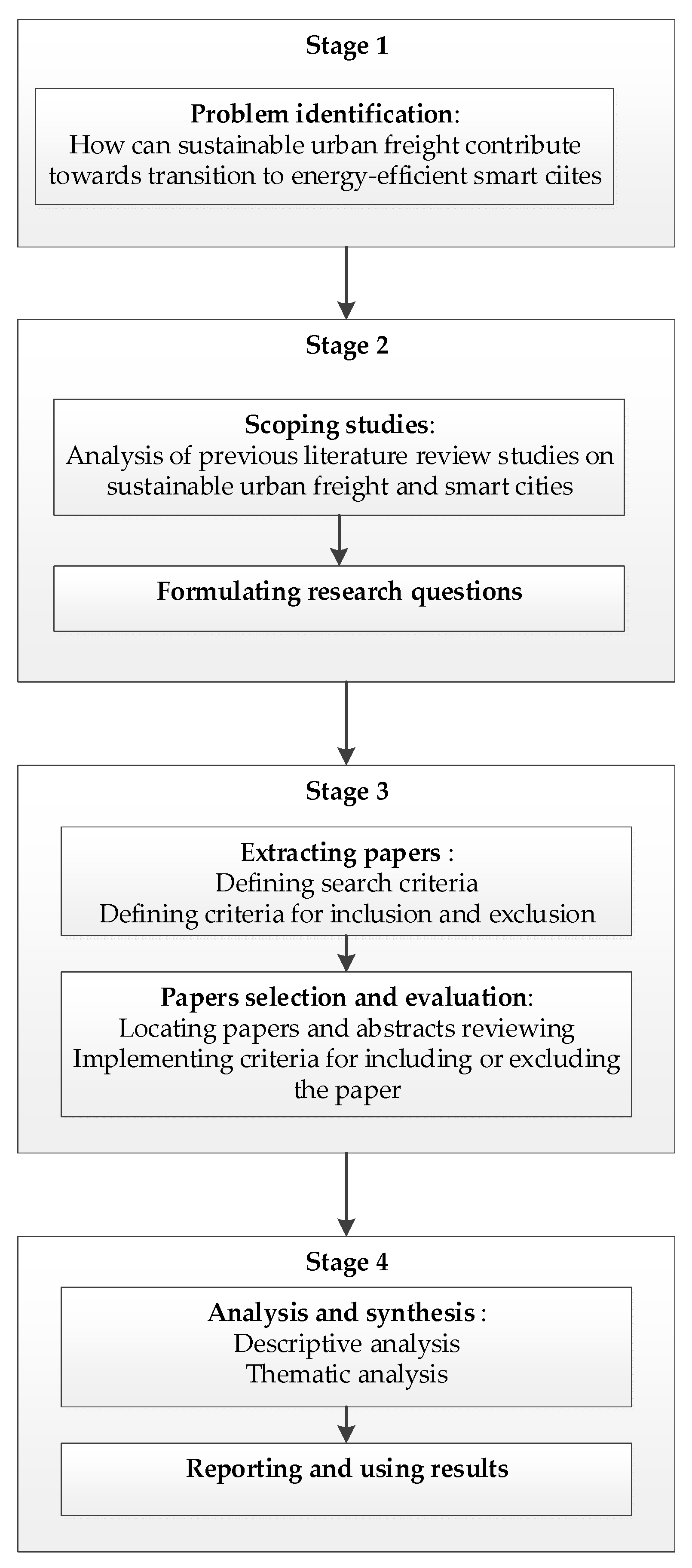

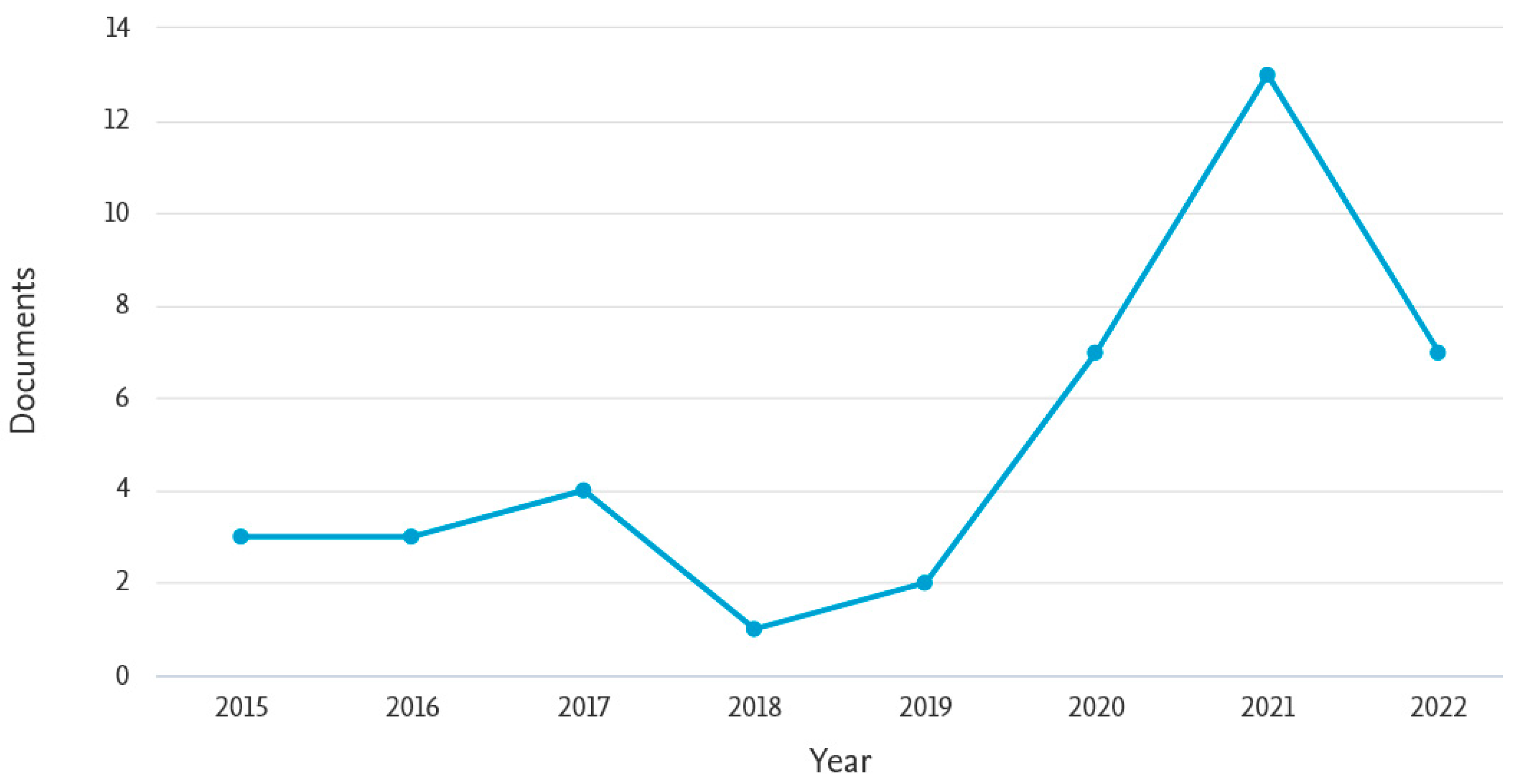
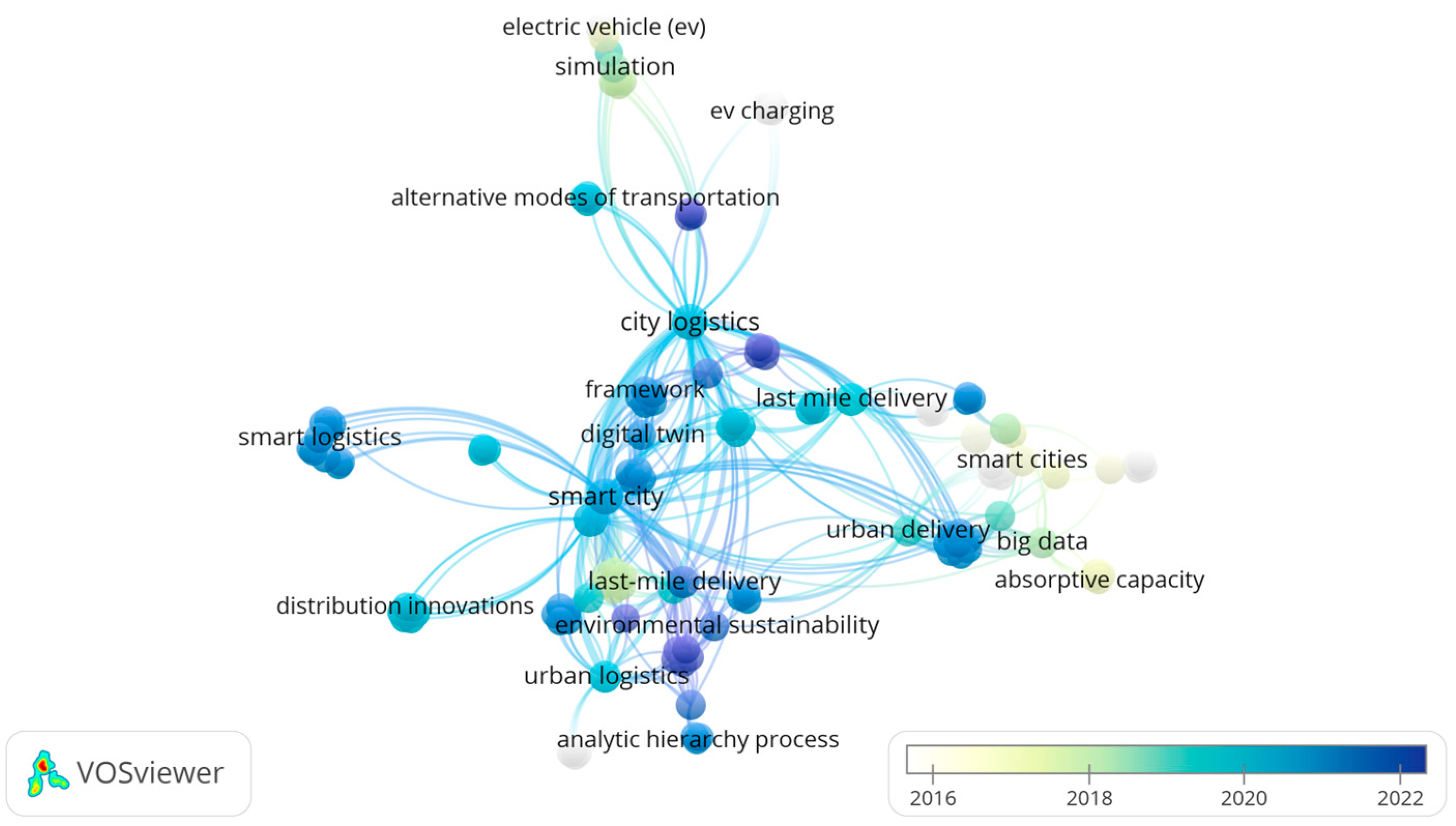


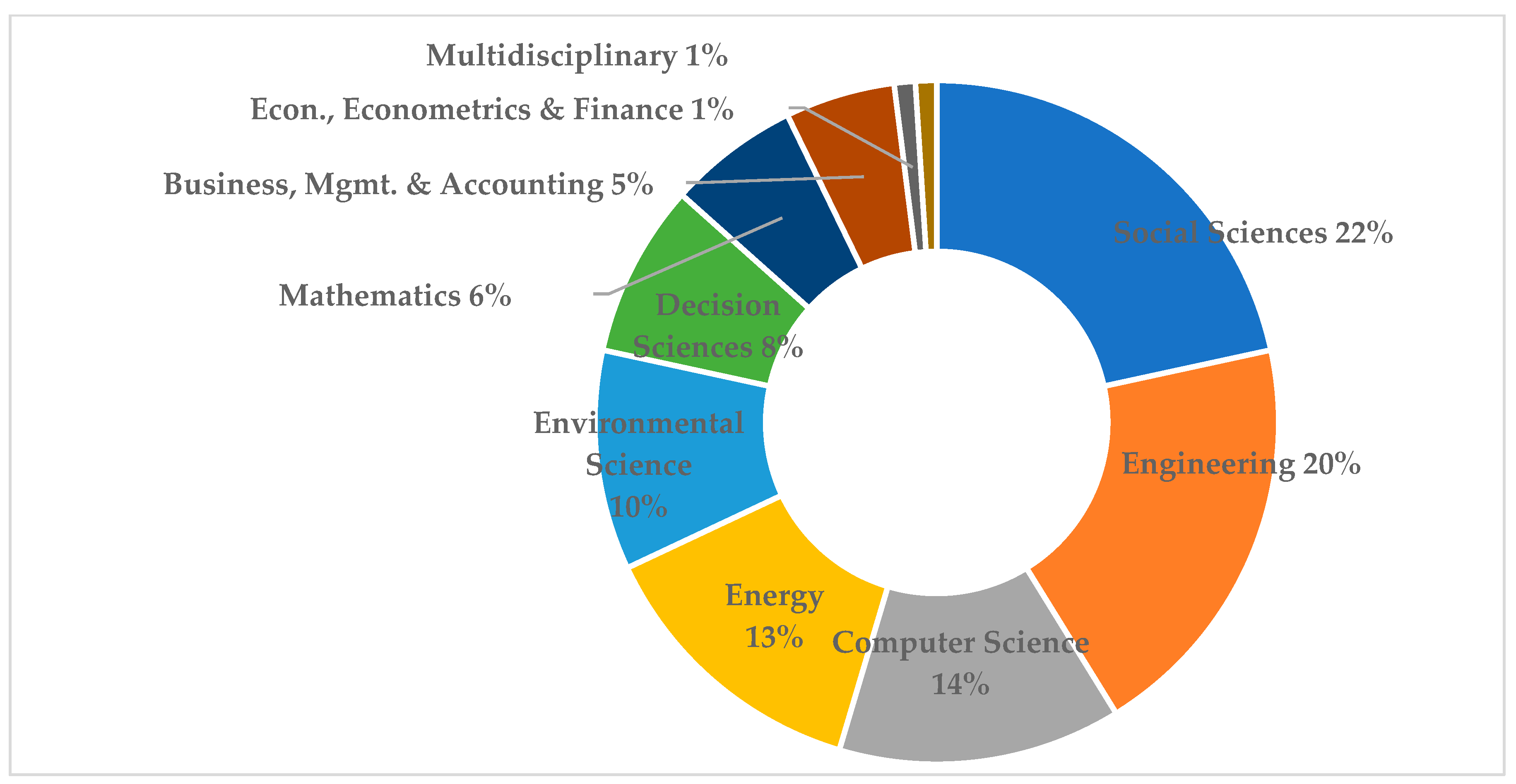
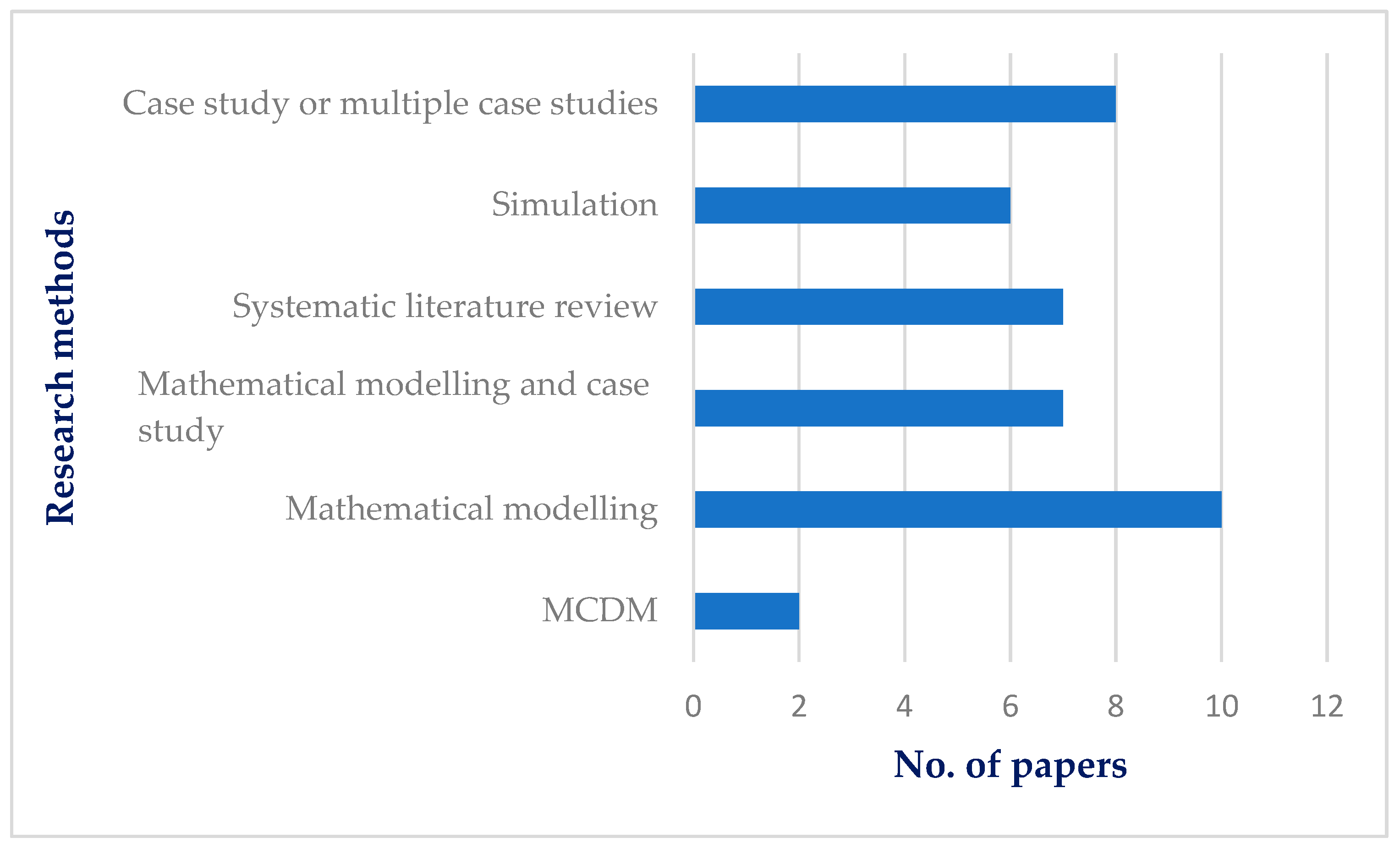
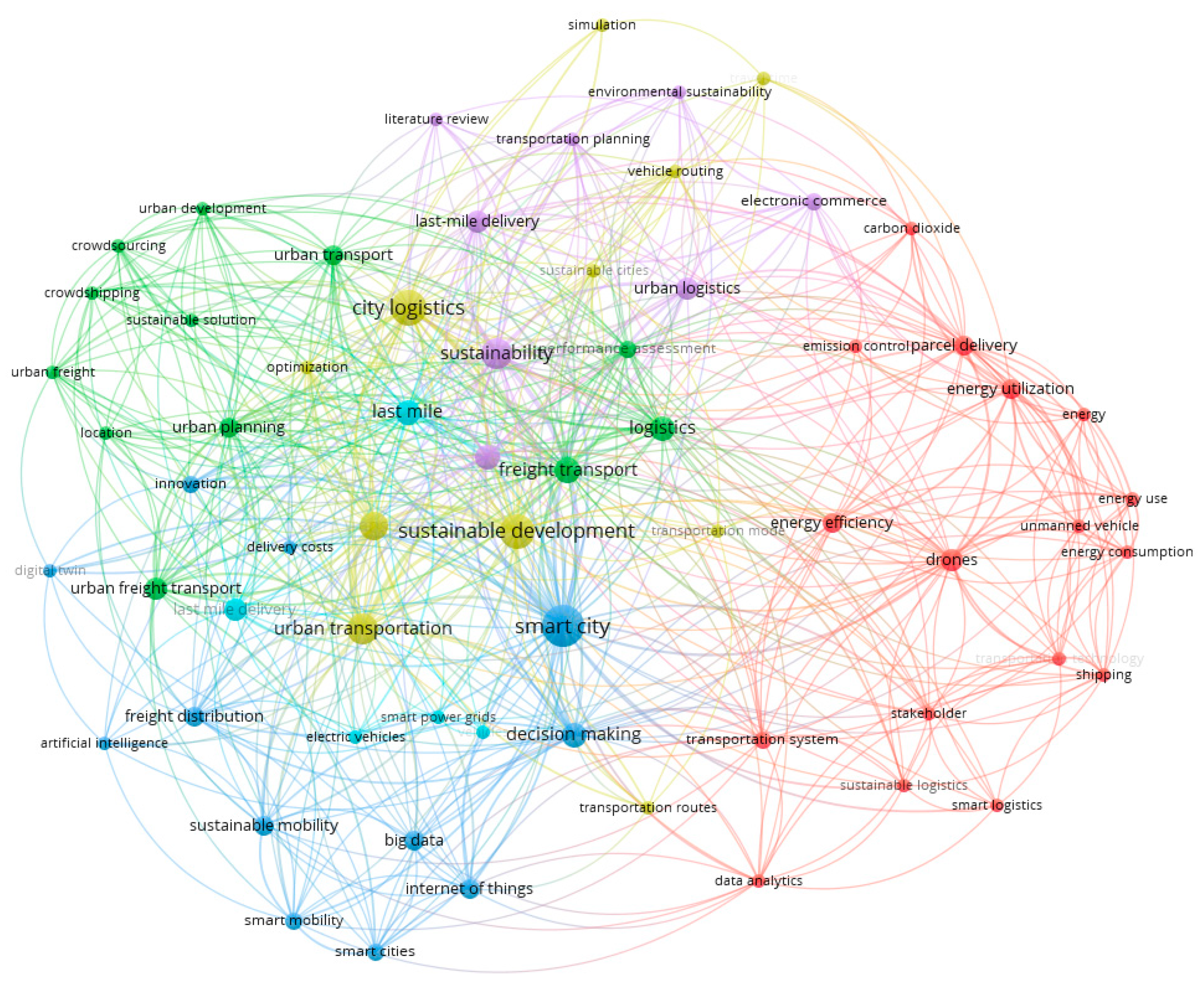
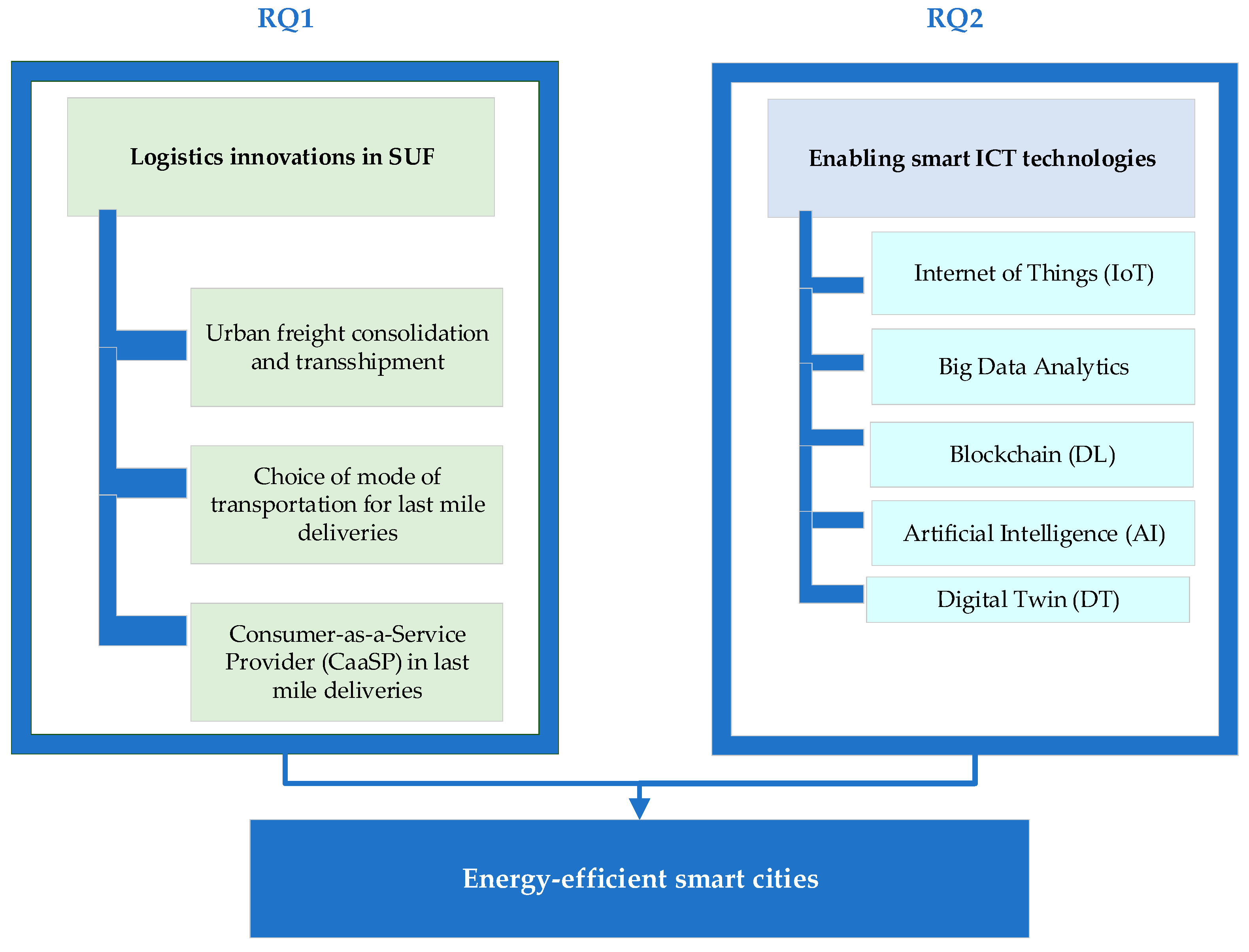

| Abbreviation | Definition |
|---|---|
| AI | Artificial Intelligence |
| B2C | Business-to-customer |
| CaaSP | Customer as a Service Provider |
| CO2 | Carbon dioxide |
| DTL | Distributed ledger technology (Blockchain) |
| DT | Digital twin |
| EU | European Union |
| GHGs | Greenhouse gases |
| GPS | Global Positioning System |
| ICT | Information communications technology |
| IoT | Internet of things |
| LMD | Last-mile delivery |
| ILMD | Innovation in last-mile delivery |
| RFID | Radio-frequency identification |
| SUF | Sustainable urban freight |
| Category | Search Criteria |
|---|---|
| Keywords | Smart city, sustainable urban freight, sustainable last mile delivery |
| Search string | TITLE-ABS-KEY (smart AND cit *) AND TITLE-ABS-KEY (sustain * AND urban AND freight) OR TITLE-ABS-KEY (sustain * AND last AND mile AND deliver *) |
| Time range | 2008–2022 * |
| Language | English |
| Type of documents | Journal, Conference Paper, |
| Authorship | Defined (author/-s name displayed) |
| Cluster 1 | Cluster 2 | Cluster 3 | Cluster 4 | Cluster 5 | Cluster 6 |
|---|---|---|---|---|---|
| carbon dioxide data analytics drones emission control energy consumption energy energy efficiency energy use energy utilization parcel delivery shipping smart logistics stakeholder sustainable logistics transportation system transportation technology unmanned vehicle | Crowd-shipping Crowd-sourcing freight transport location logistics performance assessment sustainable solution urban development urban freight urban freight transport urban planning urban transport | artificial intelligence big data decision making delivery cost digital twin innovation freight distribution internet of things smart cities smart city smart mobility sustainable mobility | city logistics freight transportation optimization simulation vehicle routing sustainable cities sustainable development transportation mode transportation routes travel time urban transportation | electronic commerce environmental sustainability last-mile delivery literature review sustainability traffic congestion transportation planning urban logistics | electric vehicles last mile last mile delivery smart power grids vehicles |
| Category | Innovations in LMD for SUF | Energy Efficiency | Papers | Intelligence * | Interconnectivity * |
|---|---|---|---|---|---|
| LMD consolidation and/or trans-shipment in SUF | Mobile depots | Lower energy demand in shared infrastructure | [39,40,55,65,66] | + | ++ |
| Parcel lockers | Lower energy demand—reduced no. of trips | [67,68,69] | ++ | ++ | |
| Micro-depots | Lower energy demand in shared infrastructure | [65,70,71,72] | ++ | ++ | |
| Consumer as a service provider (CaaSP) in SUF | Crowd-shipping | Lower energy demand—reduced distance travelled per parcel | [65,67,73] | ++ | +++ |
| Self-collection | Lower energy demand—reduced no. of trips | [69,74] | + | ++ | |
| Mode of transportation for LMD in SUF | Drones | Energy demand strongly depends on weather and urban conditions | [40,56,75,76] | +++ | +++ |
| Autonomous delivery robots | Lower energy demand, alternative energy sources | [39,40,77] | +++ | +++ | |
| Autonomous vehicles | Lower energy demand, alternative energy sources | [39,40,58,78] | +++ | +++ | |
| Cargo bikes (including e-cargo bikes, e-tricycles) | Lower energy demand, alternative energy sources | [69,70,71,79,80] | ++ | ++ | |
| Electric vehicles | Lower energy demand, alternative energy sources | [57,76,78,81,82] | ++ | ++ | |
| Combined passenger and cargo transport, rapid transit systems | Lower energy demand, reduced no. of trips | [83,84] | +++ | +++ |
| Smart Technology | Area of Application in SUF | Enabled Innovations in LMD for SUF | Research |
|---|---|---|---|
| Internet of Things (IoT) (Wireless sensors and actuators, RFID tags) | Real-time positioning/locating of vehicles, traffic monitoring, dynamic routing, real-time tracking and tracing of parcels/goods, monitoring driver’s fatigue, cargo condition monitoring, environmental scanning | Mobile depots Parcel lockers Micro-depots Crowd-shipping Autonomous delivery robots Various modes of transportation for SUF | [32,41,61,67,73,85,88,89,90] |
| Big Data Analytics | Autonomous reporting, e.g., for environmental purpose | Autonomous vehicles Electric vehicles Micro-depots Crowd-shipping | [32,41,91,92,93,94,95] |
| Blockchain (DTL) | Tracking cargo and certifying users while preserving privacy; monitoring and verifying GHG emission levels in LMD | Autonomous vehicles Micro-depots Crowd-shipping Mobile depots Parcel lockers | [41,58,61] |
| Artificial Intelligence (AI) | Advanced machine-learning techniques for identification of mobility patterns and optimization of transport services | Various modes of transportation for SUF | [41,58] |
| Digital Twin (DT) | LMD network mapping and visualizing, freight-parking management in LMD | Various modes of transportation for SUF | [96] |
Disclaimer/Publisher’s Note: The statements, opinions and data contained in all publications are solely those of the individual author(s) and contributor(s) and not of MDPI and/or the editor(s). MDPI and/or the editor(s) disclaim responsibility for any injury to people or property resulting from any ideas, methods, instructions or products referred to in the content. |
© 2023 by the authors. Licensee MDPI, Basel, Switzerland. This article is an open access article distributed under the terms and conditions of the Creative Commons Attribution (CC BY) license (https://creativecommons.org/licenses/by/4.0/).
Share and Cite
Golinska-Dawson, P.; Sethanan, K. Sustainable Urban Freight for Energy-Efficient Smart Cities—Systematic Literature Review. Energies 2023, 16, 2617. https://doi.org/10.3390/en16062617
Golinska-Dawson P, Sethanan K. Sustainable Urban Freight for Energy-Efficient Smart Cities—Systematic Literature Review. Energies. 2023; 16(6):2617. https://doi.org/10.3390/en16062617
Chicago/Turabian StyleGolinska-Dawson, Paulina, and Kanchana Sethanan. 2023. "Sustainable Urban Freight for Energy-Efficient Smart Cities—Systematic Literature Review" Energies 16, no. 6: 2617. https://doi.org/10.3390/en16062617
APA StyleGolinska-Dawson, P., & Sethanan, K. (2023). Sustainable Urban Freight for Energy-Efficient Smart Cities—Systematic Literature Review. Energies, 16(6), 2617. https://doi.org/10.3390/en16062617








